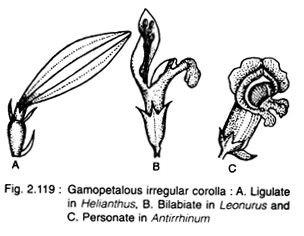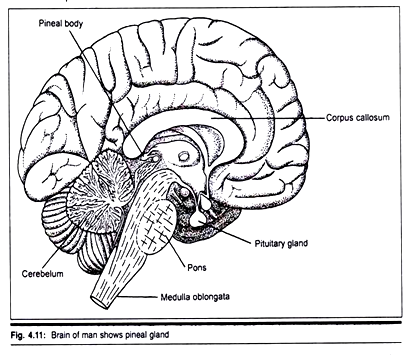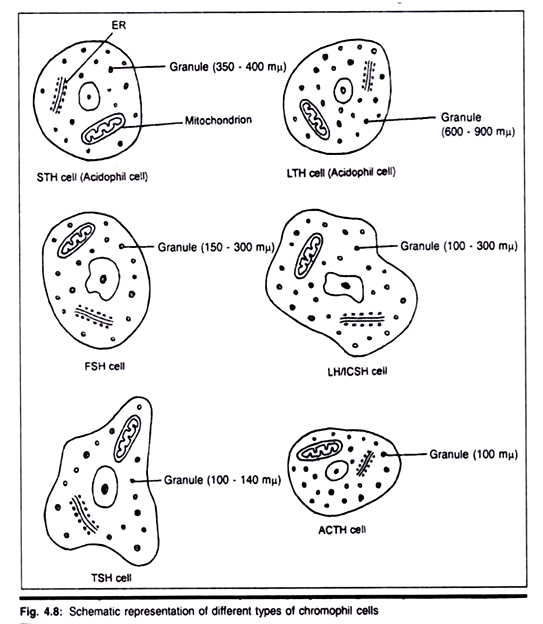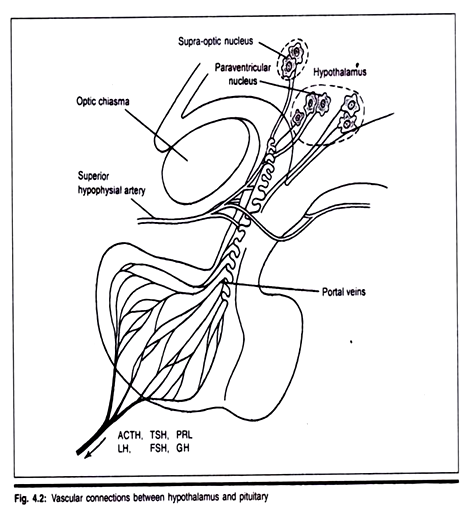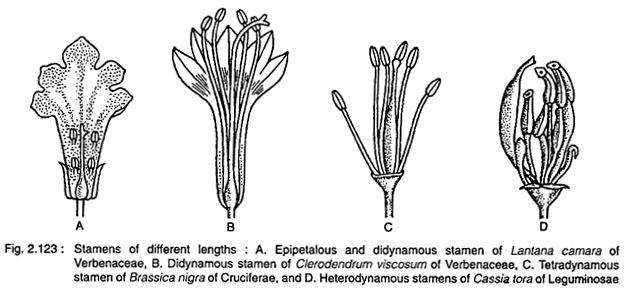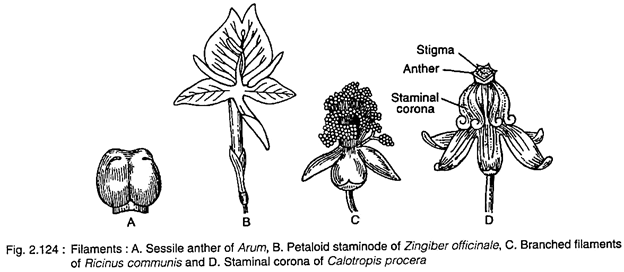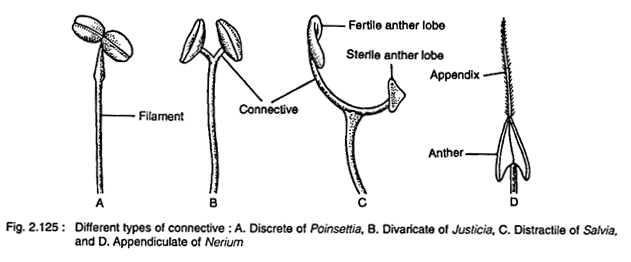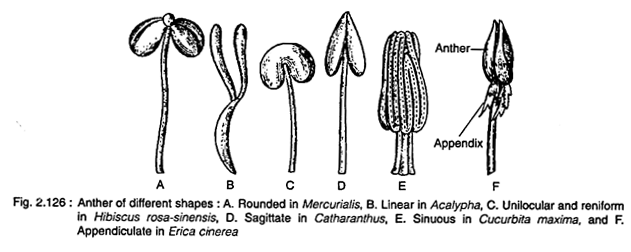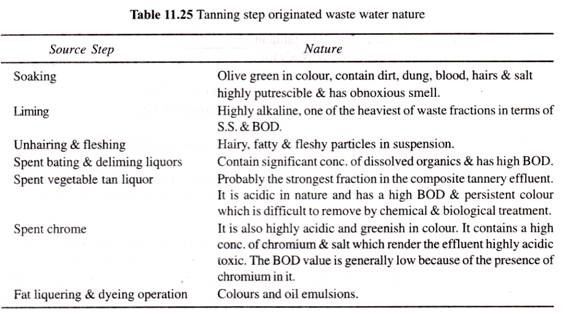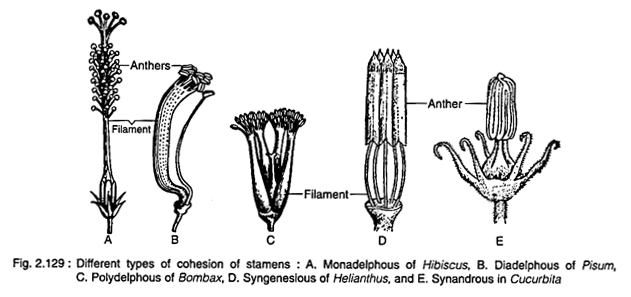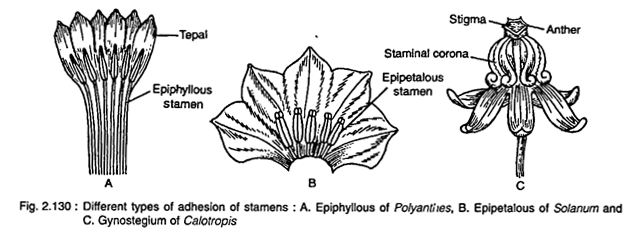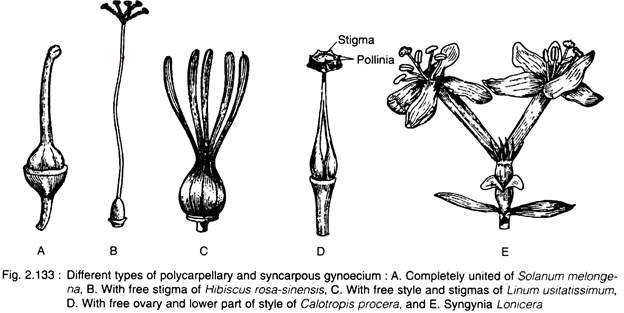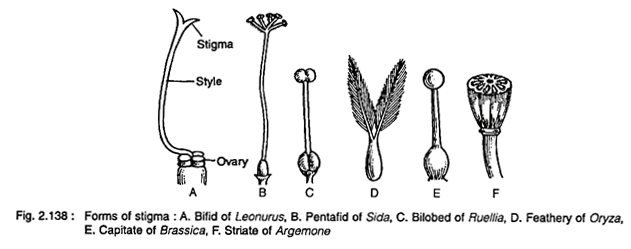ADVERTISEMENTS:
Here is an essay on the ‘Parts of a Flower’ for class 9, 10, 11 and 12. Find paragraphs, long and short essays on the ‘Parts of a Flower’ especially written for school and college students.
Essay on the Parts of a Flower
Essay Contents:
- Essay on Thalamus (Receptacle)
- Essay on Calyx
- Essay on Corolla
- Essay on Perianth
- Essay on Androecium
- Essay on Filament
- Essay on Connective
- Essay on Anther
- Essay on Stamens
- Essay on Gynoecium
- Essay on Ovary
- Essay on Style
- Essay on Stigma
ADVERTISEMENTS:
1. Essay on Thalamus (Receptacle):
The thalamus or receptacle is the short floral axis, with compressed nodes and internodes, on which the floral leaves are inserted. In a complete flower, the thalamus consists of four nodes and three compressed internodes. In a few cases, however, the internodes become elongated. The elongated or expanded internodes are named according to the position of the internode.
These are:
ADVERTISEMENTS:
1. The first expanded internode i.e., the internode between the calyx and corolla is called anthophore, e.g., Silene sp. and a few plants of Caryophylaceae.
2. The second expanded internode i.e., the internode between corolla and androecium is called androphore, e.g., passion flower, Passiflora suberosa of Passifloraceae.
3. The third expanded internode i.e., the internode between androecium and gynoecium is called gynophore, e.g., Capparis sepiaria of Capparidaceae.
When both androphore and gynophore are present in a single flower, it is called androgynophore or gynandrophore, e.g., spider flower, Gynandropsis gynandra of Capparidaceae.
The thalamus is normally terminated by the gynoecium (pistil), except the cases of monstrous development as found in wild rose, pear etc. In some cases, the thalamus is prolonged beyond the ovary and this prolongation is called carpophore, found in coriander, Coriandrum sativum (Fig. 2.110A) and anise, Foenicuium vuigare (Fig. 2.110B) of Umbelliferae; balsam, Impatiens balsamina of Balsaminaceae etc.
The thalamus may undergo modification and forms a structure known as disc. This disc often bears nectar and glands. Depends on the position, the disc may be hypogynous, perigynous or epigynous.
Insertion of Floral Leaves on the Thalamus:
The calyx, corolla, androecium and gynoecium develop on the thalamus in different orientation.
ADVERTISEMENTS:
Depending on the position of three lower whorls with respect to the position of ovary, the flowers are of three types:
A. Hypogynous Flower:
When the ovary occupies the highest position on the thalamus, and the stamens, petals and sepals are separately and successively arranged below the ovary, the flower is called hypogynous (Fig. 2.111 A, A’).
Here the ovary is superior and all other members are inferior, e.g., china- rose, Hibiscus rosa-sinensis of Malvaceae. This is very common in many dicotyledonous (Brassicaceae, Solanaceae, Ranunculaceae etc.) as well as in monocotyledonous (Arecaceae, Araceae, Commelinaceae, Liliaceae etc.) families.
ADVERTISEMENTS:
B. Perigynous Flower:
Here the thalamus becomes flattened to form a flat or cup- shaped concave structure, where the ovary remains in the centre but not at the top. The other whorls i.e., calyx, corolla and androecium remain attached on the rim of the flat (Fig. 2.111 B, B’) or concave (Fig. 2.111C, C’) thalamus.
It is called perigynous flower. Here the ovary is superior. Sometimes the ovary is said to be half inferior instead of superior, e.g., pea, Pisum sativum of Fabaceae; rose, Rosa centifolia of Rosaceae; Portulaca oleracea of Portulacaceae etc.
C. Epigynous Flower:
ADVERTISEMENTS:
Here the margin of the thalamus (grows further upward) completely encloses the ovary and getting fused with it. Thus the flower bears the calyx, corolla and androecium which remain above the ovary.
It is called epigynous flower (Fig. 2.111D, D’). The ovary in such cases is said to be inferior and the rest of the floral members are superior. Viz. sunflower, Helianthus annuus of Compositae; red pumpkin, Cucurbita maxima of Cucurbitaceae etc.
2. Essay on Calyx:
ADVERTISEMENTS:
Calyx is the outermost (lowermost) whorl, made up of sepals. The sepals are usually green in colour, but sometimes coloured i.e., like petals, called petaloid or petaline, e.g., cumin, Nigella sativa of Ranunculaceae; Saraca indica of Fabaceae (Leguminosae). The number of sepals is generally three in monocotyledons and four to five in dicotyledons.
Calyx may be regular or irregular in shape. Depending on the various nature of calyx, they are grouped variously.
A. Based on the arrangement of the unit member of calyx, i.e., sepals, they are of two types:
a. Polysepalous, and
b.Gamosepalous.
a. Polysepalous:
ADVERTISEMENTS:
When the sepals remain free, they are called polysepalous, e.g., mustard, Brassica nigra (Fig. 2.112A) of Brassicaceae etc.
b. Gamosepalous:
When the sepals remain united, they are called gamosepalous, e.g., Leonurus sibiricus (Fig. 2.112B) of Lamiaceae, Datura metel (Fig. 2.112C) of Solanaceae, Hibiscus rosa-sinensis of Malvaceae etc.
B. Based on the duration of attachment of sepals upon the flower, they are divided into three types:
a. Caducous or Fagacious:
ADVERTISEMENTS:
If the calyx falls just at the time of opening of flower from bud, it is called caducous, e.g., poppy, Papaver somniferum (Fig. 2.113A) of Papaveraceae etc.
b. Deciduous:
Here the calyx remains attached on the flower until the flower withers, e.g., mustard, Brassica nigra of Brassicaceae etc.
c. Persistent:
If the calyx remains attached even on fruit, it is called persistent.
It is of two types:
(i) Marcescent:
The calyx remains persistent but ceases to grows further, e.g., tomato, Lycopersicum esculentum and brinjal, Solanun melongena (Fig. 2.113B) of Solanaceae.
(ii) Accrescent:
The calyx remains persistent and grows further along with the development of the fruit, e.g., coconut, Cocos nucifera of Arecaceae (Palmae); Dillenia indica (Fig. 2.113C) of Dilleniaceae etc.
Modification of Calyx:
Sometimes sepals are modified into various forms, such as:
a. Pappus:
When the sepals are modified into hairy or bristly structure, it is called pappus, e.g., Mikania scandens (Fig. 2.114A) and other members of Asteraceae, etc.
b. Leafy:
Here sepal(s) are modified into leaf like structure, e.g., Mussaenda frondosa -one sepal (Fig. 2.114B) or M. philippica (all the five sepals) of Rubiaceae etc.
c. Spinous:
Here sepals are modified into spines, e.g. Trapa bispinousa (Fig. 2.114C) of Onagraceae.
d. Spurred:
When the calyx is modified into long tubular or beak-like structure, it is called spurred, e.g., Impatiens balsamina (Fig. 2.114D) of Balsaminaceae, Delphinium sp. of Ranunculaceae etc.
e. Hooded:
Here the calyx is modified into hood, thus covering the whole flower, e.g., Aconitum sp. (Fig. 2.114E) of Ranunculaceae etc.
3. Essay on Corolla:
Corolla is the second floral whorl from outside, consisting of petals. Petals are generally broad and bright-coloured; those are inserted on the thalamus by a comparatively narrow base, e.g., Hibiscus rosasinensis (Fig. 2.115A). Sometimes the petals are green in colour, called sepaloid or sepaline, e.g., Polyalthia longifolia, Annona squamosa of Annonaceae; Pergularia daemia of Asclepiadaceae.
Sometimes, the lower part of the petal becomes very thin and looks like a stalk, called claw and the upper expanded portion is called limb (Brassica campestris, Fig. 2.115B). The number of petals is variable i.e., from one to many.
Corolla may be regular or irregular in shape. Depending on the nature of sepals, they are grouped variously.
A. Based on the arrangement of the unit member of corolla i.e., petals, they are of two types:
a. Polypetalous and
b. Gamopetalous or Sympetalous.
a. Polypetalous:
When the petals remain free, they are called polypetalous, e.g., mustard, Brassica nigra of Brassicaceae etc.
b. Gamopetalous or Sympetalous:
When the petals remain united, they are called gamopetalous, e.g., Lantana camara of Verbenaceae; Catharanthus roseus of Apocynaceae etc. Sometimes, the gamopetalous corolla forms a lower tubular structure, called corolla tube and the free upper region is called corolla lobes. The junction point between the tube and the lobes is called throat.
Appendages of Corolla:
Sometimes different types of appendages develop on the corolla.
These are:
1. Saccate or Gibbous:
When the lower region of the corolla tube becomes dilated to form a sac-like or pouch-like structure, it is called saccate or gibbous, e.g., snapdragon, Antirrhinum majus (Fig. 2.116A), Calceolaria mexicana of Scrophulariaceae; Veleriana sp. of Velerianaceae etc.
2. Corona:
When appendages develop in the form of hair-like or scaly outgrowths of various types, at the base of petals or in between claw and limb, they are called corona, e.g., Passiflora suberosa of Passifloraceae; Nerium indicum (Fig. 2.116B) of Apocynaceae; Scoparia dulcis of Scrophulariaceae; Daffodil, Narcissus pseudonarcissus of Amaryllidaceae (Fig. 2.116C) etc.
3. Spurred or Calcarate:
Here petal or petals are prolonged to form a tube-like structure, called spurred or calcarate, e.g., Delphinum majus and Aquilegia sp. (Fig. 2.116D) of Ranunculaceae; Viola tricolor of Violaceae etc.
Forms of Corolla:
The corolla is of various types.
The principal types are grouped variously and described:
1. Polypetalous and Regular:
a. Cruciform:
Here four clawed petals are arranged crosswise in one whorl, e.g., mustard, Brassica nigra (Fig. 2.117A) and radish, Raphanus sativa of Brassicaceae.
b. Caryophyllaceous:
Here corolla consists of five-clawed petals with spreading limbs i.e., the limbs and the claws are at right angles to each other, e.g., Dianthus chinensis (Fig. 2.117B) and Saponaria vaccaria of Caryophyllaceae.
c. Rosaceous:
Here corolla consists of five or many petals without or with very short claws having outwardly spreading very wide limbs e.g., wild rose, Rosa lucida (Fig. 2.117C) of Rosaceae; tea, Cammelia sinensis of Ternstroemiaceae etc.
2. Polypetalous and Irregular:
Papilionaceous:
Here, out of five irregular free petals, the posterior odd petal is the largest and outermost (i.e., the vexillum or standard), which overlaps the two lateral petals (i.e., the wings or alae) and the lateral petals in their turn partially overlap the two smallest and innermost petals (i.e., the keel or carina). Viz. Corolla of all members belonging to the sub-family Papilionaceae under Family Fabaceae, such as pea, Pisum sativum (Fig. 2.117D, E); Sesbania grandriflora, Clitoria ternatea etc.
3. Gamopetalous and Regular:
a. Tubular:
Here all the petals are united to form a corolla tube, which is more or less cylindrical, e.g., disc florets of sunflower, Helianthus annuus (Fig. 2.118A) and many other members of Asteraceae.
b. Campanulate or Bell-Shaped:
Here corolla forms bell-shaped structure, e.g., gourd, Cucurbita maxima of Cucurbitaceae; yellow oleander, Thevetia peruviana of Apocynaceae; Physalis peruviana (Fig. 2.118B) of Solanaceae etc.
c. Rotate or Wheel-Shaped:
Here the corolla tube is short with spreading wheel-shaped limbs develop at right angles to the tube, e.g., Scoparia dulcis of Scrophulariaceae; brinjal, Solanum melongena (Fig. 2.118C) of Solanaceae; Calotropis procera of Asclepiadaceae etc.
d. Hypocrateriform or Salver-Shaped:
Here the corolla tube is long and slender with spreading limbs develop at right angles to the tube (like the rotate type), e.g., Ixora coccinea of Rubiaceae; Ipomoea quammoclit of Convolvulaceae; Catharanthus roseus (Fig. 2.118D) of Apocynaceae etc.
e. Infundibuliform or Funnel-Shaped:
Here the corolla is tubular below and gradually becomes widen at the top like that of a funnel, e.g., morning glory, Ipomoea pulchella (Fig. 2.118E) of Convolvulaceae; Ruellia tuberosa of Acanthaceae; thorn apple, Datura fastuosa of Solanaceae etc.
f. Urceolate or Urn-Shaped:
Here the corolla tube becomes inflated in the middle and comparatively narrow at both the ends, e.g., Rhododendron sp. of Ericaceae; Bryophyllum calycinum (Fig. 2.118F) of Crassulaceae etc.
4. Gamopetalous and Irregular:
a. Ligulate or Strap-Shaped:
Here the upper part of corolla is flattened like a strap and the lower part forms a short tube, e.g., ray florets of sunflower, Helianthus annuus (Fig. 2.119A) and many other members of Asteraceae.
b. Bilabiate or Two-Lipped:
Here the upper part of corolla tube is divided into two lips with a wide mouth which remains open at the throat, e.g., Ocimum sanctum, Anisomeles indica, Leucas linifolia, Leonurus sibiricus (Fig. 2.119B) of Lamiaceae; Andrographis paniculata, Adhatoda vasica of Acanthaceae etc.
c. Personate or Masked:
Here the limb of corolla is two-lipped like bilabiate, but the mouth remains closed by a projection (palate) of the lower lip, e.g., snapdragon, Antirrhinum majus (Fig. 2.119C), Lindenbergia indica of Scrophulariaceae etc.
4. Essay on Perianth:
In majority of the monocotyledonous flower, the calyx and corolla are not differentiated and form a single accessory whorl, the perianth as found in Crinum, Polyanthes (Fig. 2.120A) etc. The unit member of the perianth is called tepal. In Poaceae (Cramineae), the perianth becomes very simple and represented by two to three membranous structures, the lodicules, e.g., Festuca pratensis (Fig. 2.120B), Oryza sativa etc.
The perianth is often green (sepaloid), e.g coconut, Cocos nucifera of Arecaceae or brightly-coloured (Petaloid), e.g., glory lily, Gloriosa superba of Liliaceae (Fig. 2.120C); tuberose, Polyanthes tuberosa of Amaryllidaceae; water hyacinth, Eichhornia crassipes of Pontederiaceae etc.
When the members of the perianth remain free from one another, they are called polyphyllous, e.g., Asparagus racemosus and glory lily, Gloriosa superba of Liliaceae; but when the members remain united, they are called gamophyllous, e.g., Polyanthes tuberosa of Amaryllidaceae etc.
Aestivation or Prefoliation:
The aestivation is the pattern of arrangement of sepals, petals and tepals with respect to one another in budding stage.
It is of the following five types (Fig. 2.121):
1. Valvate:
Here the margins of sepals, petals or tepals either touch or lie in close association, but they do not overlap (Fig. 2.121 A, A’), e.g., calyx of china-rose, Hibiscus rosa- sinensis of Malvaceae; both calyx and corolla of sensitive plant, Mimosa pudica and gum tree, Acacia nilotica of Fabaceae etc.
2. Twisted or Contorted:
Here one margin of each sepal, petal or tepal overlaps the margin of neighbouring one (Fig. 2.121B, B’), e.g., corolla (petals) of china-rose, Hibiscus rosa-sinensis of Malvaceae; corolla of karabi, Nerium odoratum of Apocynaceae etc.
3. Imbricate:
Here the margins of sepals, petals or tepals are arranged in such a manner that one becomes completely external, another completely internal, and the rest members are arranged like that of twisted one (Fig. 2.121C, C’), e.g., petals of Solanum torvum, and Nicotiana tabacum of Solanaceae; petals of Clerodendrum viscosum of Verbenaceae etc.
4. Quincuncil:
When the margins of sepals, petals or tepals are arranged in such a manner that the two become completely external, other two completely internal and the rest members are like that of twisted (Fig. 2.121D, D’), e.g., petals of Lantana camara of Verbenaceae; sepals of Holarrhena antidysenterica of Apocynaceae etc.
5. Vexillary:
In this type, out of five members the posterior odd petal is the largest and outermost (i.e., the vexillum), which overlaps the two lateral petals (i.e., the wings) and the lateral petals in their turn partially overlap the two smallest and innermost petals (i.e., the keel) (Fig. 2.121E, E’). Viz. corolla of all members belonging to the subfamily Papilionaceae under Family Fabaceae (Leguminosae).
5. Essay on Androecium:
Androecium is the first set of essential whorl vis-a-vis the third set of the floral whorl. The unit member of the androecium is stamen. They look quite different from sepals and petals.
Stamen generally consists of an elongated stalk, the filament and bears at its apex a saclike structure, the anther (Fig. 2.122). Generally, each anther consists of two anther lobes which are connected by a tissue formed by the extension of the filament, called the connective. The connective is visible towards the dorsal side of the anther lobes. There are longitudinal grooves or sutures along the ventral face of the anther demarcating the pollen chambers.
Each anther lobe has two chambers, called pollen sacs or microsporangia. Each stamen, therefore, consists of four microsporangia and each micro- sporangium contains innumerable number of pollen grains or microspores. The anthers generally have two lobes, thus called dithecous, but in Malvaceae, it is with one lobe and is called monothecous.
The number of stamens varies from one to many.
Depending on the number of stamens, the flowers are grouped as:
a. Monandrous:
Flowers are with one stamen, e.g., turmeric, Curcuma longa and ginger, Zingiber officinale of Zingiberaceae etc.
b. Diandrous:
Flowers are with two stamens, e.g., Adhatoda vasica of Acanthaceae etc.
c. Triandrous:
Flowers are with three stamens, e.g., wheat, Triticum aestivum of Poaceae; Scirpus articulatus, Cyperus rotundus and many members of Cyperaceae.
d. Tetrandrous:
Flowers are with four stamens, e.g., sacred basil, Ocimum sanctum, Leonurus sibiricus of Lamiaceae etc.
e. Pentandrous:
Flowers are with five stamens, e.g., Solanum nigrum and brinjal, S. melongena of Solanaceae; Ipomoea sinensis of Convolvulaceae etc.
f. Hexandrous:
Flowers are with six stamens, e.g., paddy, Oryza sativa and bamboo, Bambusa tulda of Gramineae etc.
g. Polyandrous:
Flowers are with numerous stamens, e.g., rose, Rosa centifolia of Rosaceae; castor, Ricinus communis of Euphorbiaceae, Acacia nilotica of Fabaceae etc.
On the thalamus, the floral members may arrange in one or in many whorls, or they may arrange spirally as in Magnolia grandiflora of Magnoliaceae.
Usually, there is only one whorl of stamens, which alternate with the petals. Sometimes, two or more whorls of stamens are present and these may alternate with the petals or lie opposite to them. When the stamens lie alternate with the petals (opposite to the sepal), they are called antisepalous and on the other hand, if they alternate with the sepals (opposite to the petals), they are called antipetalous.
Depending on the number of whorl and their arrangement, they are of the following types:
a. Haplostemonous:
When there is one whorl of stamens, which usually alternate with the petal, it is called haplostemonous, e.g., morning glory, Ipomoea pulchella and many other plants of Convolvulaceae.
b. Diplostemonous:
When the stamens are arranged in two whorls and each stamen of outer whorl is opposite to a sepal (antisepalous), while each stamen of inner whorl is opposite to a petal (antipetalous), it is called diplostemonous, e.g., Cassia fistula of Fabaceae etc.
c. Obdiplostemonous:
When the stamens are in two whorls with those in outer whorl opposite to petals and those in the inner whorl opposite to sepals, it is called obdiplostemonous. e.g., many members of Rutaceae, Caryophyllaceae, Geranium sp. of Geraniaceae etc.
d. Polystemonous:
When stamens occur in more than two whorls, it is called polystemonous. e.g., Delphinium sp. of Ranunculaceae etc.
In a flower, when the number of stamens is equal to the number of sepals, petals and carpels, then the androecium is called isostemonous.
Depending on the position of stamens on the thalamus with reference to ovary, they may also be hypogynous, perigynous and epigynous.
The stamens in an androecium vary in length and accordingly they are of the following types:
a. Didynamous:
There are four stamens in one whorl in which two are longer than the other two, it is termed as didynamous type, e.g., Leonurus and other members of Lamiaceae; also common in Acanthaceae, Scrophularia ceae and Verbenaceae (Fig. 2.123A,B) etc.
b. Tetradynamous:
When six stamens are in two whorls in which two of the outer whorl are shorter than the four of the inner whorl, it is termed as tetradynamous type, e.g., mustard, Brassica nigra (Fig. 2.123C) and other members of Brassicaceae, etc.
c. Heterodynamous:
When stamens of different lengths occur in one whorl, it is termed as heterodynamous type, e.g., Cassia tora (Fig. 2.123D) of Fabaceae.
6. Essay on Filament:
The elongated stalk-like structure, situated at the base of an anther of a stamen, is called filament. The stamens may be without filament i.e., sessile (Arum maculatum, Fig. 2.124A) of Araceae. The filament may not bear fertile anther i.e., sterile and is called staminode (Cassia sophera, Fig. 2.123D of Fabaceae).
In Canna of Cannaceae, Zingiber officinale (Fig. 2.124B) of Zingiberaceae, the sterile stamens form petal like structure, the petaloid staminode. The gradual transition from petal to stamen is observed in Indian blue lotus, Nymphaea stellata and white water lily, Nymphaea alba (Fig. 2.105B) of Nymphaeaceae.
Normally the filaments are unbranched, but it may be branched as in castor, Ricinus communis (Fig. 2.124C) of Euphorbiaceae. Sometimes it bears horny appendages, called staminal corona, found in Calotropis procera (Fig. 2.124D) of Asclepiadaceae.
7. Essay on Connective:
The connective is a tissue which connects the two parallel anther lobes.
It is of different types:
a. Discrete:
The connective is very small or wanting, where the anther lobes remain very close to each other, e.g., Poinsettia pulcherrima (Fig. 2.125A) of Euphorbiaceae.
b. Divaricate:
The connective develops in such a way that the anther lobes get separated from each other, e.g., Lindenbergia indica of Scrophulariaceae, Justicia gendarussa (Fig. 2.125B) of Acanthaceae etc.
c. Distractile:
The connective is long stalk-like body which separates the two anther lobes, of which one is sterile and the other one is fertile, e.g., Salvia plebeja (Fig. 2.125C) of Lamiaceae.
d. Appendiculate:
The connective is prolonged beyond the anther into a feathery appendix, e.g., oleander, Nerium indicum (Fig. 2.125D) of Apocynaceae.
8. Essay on Anther:
Generally the anthers are bilobed and quadrilocular, but rarely the anthers become unilocular (Fig. 2.126C) either due to abortion of one lobe and destruction of partition wall between the chamber or destruction of all partition tissue. One-chambered i.e., unilocular anther is found in the family Malvaceae.
The anthers may be of different shapes. It may be rounded (Mercurialis annua of Euphorbiaceae, Fig. 2.126A), linear (Acalypha indica of Euphorbiaceae, Fig. 2.126B), reniform (Hibiscus rosa-sinensis of Malvaceae, Fig. 2.126C), sagittate (Catharanthus roseus of Apocynaceae, Fig. 2.126D), sinuous i.e., rolled- up like an inverted ‘S’ (gourd, Cucurbita maxima of Cucurbitaceae, Fig. 2.126E), appendiculate (Erica cinerea of Ericaceae, Fig. 2.126F) etc.
The ventral side of the anther generally faces inwardly towards the centre of the flower, it is called introrse (Polyanthes tuberosa of Amaryllidaceae, Nymphaea stellata of Nymphaeaceae etc.) and when it faces outwardly towards the petal, it is called extrorse (Colchicum luteum and Gloriosa superba of Liliaceae etc.).
Attachment of Anther with the Filament:
The anther becomes attached with the filament in different ways.
These are:
a. Adnate:
The filament or the connective remains attached to the back of the anther throughout the whole length (Fig.2.127A), e.g., Magnolia sp. of Magnoliaceae, Nymphaea sp. of Nymphaeaceae etc.
b. Basifixed or Innate:
The apex of the filament becomes firmly attached to the base of the anther (Fig. 2.127B), e.g., Brassica sp. of Brassicaceae, Solanum sp. of Solanaceae, Carex sp. of Cyperaceae etc.
c. Dorsifixed:
The apex of the filament becomes firmly attached to the back of the anther (Fig. 2.127C), e.g., Sesbania sp. of Fabaceae, Passiflora sp. of Passifloraceae, Polianthes tuberosa of Amaryllidaceae etc.
d. Versatile:
The apex of the filament becomes attached at a point near the middle of the back of the connective, so that the anther can move freely (Fig. 2.127D), e.g., wheat, Triticum aestivum and rice, Oryza sativa of Poaceae; glory lily, Gloriosa superba of Liliaceae etc.
Dehiscence of Anthers:
The pollen grains inside the mature anther exert some pressure on the outer wall, thereby the anther lobes burst open and the pollen grains are set free.
The dehiscence may be of different types:
a. Longitudinal:
The anther lobes burst lengthwise along the line of suture from base to apex (Fig. 2.128A), e.g., Datura sp. of Solanaceae; Vitis vinifera of Vitaceae etc.
b. Transverse:
The anther splits up transversely (as the suture is present crosswise) (Fig. 2.128B), e.g., china-rose, Hibiscus rosasinensis and other members of Malvaceae.
c. Apical or Porous:
Pollens are discharged through apical pores (Fig. 2.128C), e.g., potato, Solanum tuberosum; brinjal, S. melongena and many other members of Solanaceae.
d. Valvular:
Pollens are discharged through a trap-door-like valve formed on the anther wall, e.g., Berberis vulgaris of Berberidaceae, Cinnamomum zeylanicum and Laurus nobilis (Fig. 2.128D) of Lauraceae etc.
9. Essay on Stamens:
Union of Stamens:
Union of stamens among themselves is known as cohesion, and the union of stamens with other members i.e., perianth, petal or gynoecium is known as adhesion.
Cohesion of Stamens:
When the stamens are united by their filaments only (anthers remain free), it is called adelphous condition, and when the stamens are united by their anthers only (filaments remain free), it is called syngenesious condition. If, however, the filaments as well as the anthers of different stamens become united, it is called synandrous condition.
The cohesion may be of the following types:
a. Monadelphous:
All stamens are united by their filaments (anthers remain free), so forming a tube around style, e.g., china-rose, Hibiscus rosa-sinensis (Fig. 2.129A); lady’s finger, Abelmoschus esculentus and other members of Malvaceae; few members of Euphorbiaceae, Fabaceae etc.
b. Diadelphous:
The filaments are united (anthers remain free) and form two bundles, e.g., pea, Pisum sativum (Fig. 2.129B); gram, Cicer arietinum and some other members of Fabaceae.
c. Polydelphous:
The filaments are united in more than two bundles and anthers remain free, e.g., Bombax ceiba (Fig. 2.129C) of Bombacaceae; lemon, Citrus sp. of Rutaceae etc.
d. Syngenesious:
The anthers are united into a bundle, but filaments remain free, e.g., sunflower, Helianthus annuus (Fig. 2.129D) of Asteraceae etc.
e. Synandrous:
The anthers as well as filaments are united throughout their length to form a compact body, e.g., gourd, Cucurbita maxima (Fig. 2.129E) and many members of Cucurbitaceae.
Adhesion of Stamens:
Adhesion of stamens is of the following types:
a. Epiphyllous:
The stamens are attached to or arise from perianths, e.g., tuberose, Polyanthes tuberosa (Fig. 2.130A); spider lily, Crinum asiaticum and other plants of Amaryllidaceae etc.
b. Epipetalous:
The stamens are attached to or arise from petals, e.g., Solanum nigram (Fig. 2.130B) of Solanaceae, Lantana camara of Verbenaceae, Catharanthus roseus of Apocynaceae etc.
c. Gynandrous:
The stamens are attached with the gynoecium, either wholly or by anthers only. In the members of Asclepiadaceae (Calotropis procera, (Fig. 2.130C), the stamens adnate to the stigma i.e., gynostegium, but in Orchidaceae the adnation of stamens takes place with the style and stigma forming gynostemium.
10. Essay on Gynoecium:
The gynoecium, also called pistil (Fig. 2.131 A, B), is the innermost or the topmost whorl on the thalamus.
It is differentiated into three regions:
a. Ovary:
It is the lowermost swollen part containing ovules.
b. Style:
It is the elongated stalk or thread-like part attached to the apex of the ovary.
c. Stigma:
It is the apex of the style, the receptive region on which pollen grains are deposited during pollination.
The sterile pistil or gynoecium (devoid of functional ovule) is called pistillode.
The gynoecium consists of one or more carpels, the unit of pistil.
It is of two types:
A. Simple or Monocarpellary:
When the gynoecium is made up of one carpel, it is called simple or monocarpellary gynoecium, e.g., members of Fabaceae (Fig. 2.132A) and Poaceae (Gramineae).
B. Compound or Polycarpellary:
When the gynoecium is made up of two or more carpels, it is called compound or polycarpellary gynoecium, e.g., members of Solanaceae, Lamiaceae, Malvaceae etc.
The polycarpellary gynoecium is of two types:
a. Apocarpous:
The carpels remain completely free from one another, e.g., Members of Magnoliaceae (Fig. 2.132B), Alismaceae, Ranunculaceae, Nymphaeaceae etc.
b. Syncarpous:
The carpels are united with each other. This type is very common in angiospermic families like Brassicaceae, Malvaceae, Liliaceae, Asteraceae (Compositae) etc.
In syncarpous gynoecium, the cohesion of carpels are of different types:
1. Carpels are united throughout their length (Fig. 2.133A), e.g., Acanthaceae, Solanaceae, Boraginaceae etc.
2. Carpels are united at the ovary and style, but the stigmas are free (Fig. 2.133B), e.g., Malvaceae etc.
3. Carpels are united at the ovary but the style and stigma remain free (Fig. 2.133C), e.g., Linum usitatissimum of Linaceae.
4. Carpels are free, except at the upper part of style and stigma (Fig. 2.133D), e.g., Asclepiadaceae, Apocynaceae etc.
5. Ovaries of two adjoining flowers may fuse, while other parts of the flowers remain free (i.e., syngynia), e.g., Lonicera sp. (Fig. 2.133E).
11. Essay on Ovary:
The ovary is the swollen region formed by the folding up of the lamina (i.e., carpel), containing one or many ovules. The ovules develop into seeds. The foliar origin of ovary is evidenced in the simple ovary of pea, Pisum sativum of Fabaceae (Fig. 2.134A, B and C). One can easily understand that a leaf-like carpel i.e., the megasporophyll becomes folded towards the midrib and forms one-chambered ovary by the fusion of the margins.
The marginal line through which the carpel fuses is called ventral suture and the midrib being the dorsal suture. The ovules or megasporangia usually develop on placenta produced on the inner surface of the united margins of the carpel.
Depending on the position of ovary on the thalamus with respect to other floral whorls, it is of the following types:
a. Superior:
The ovary is situated at the top on the thalamus with respect to other floral whorls, e.g., members of Solanaceae, Lamiaceae, Malvaceae; Fig. 2.135A) etc.
b. Inferior:
The ovary is situated on the thalamus at a level lower than the other floral whorls, e.g., Members, of Cucurbitaceae (Fig. 2.135B), Rubiaceae, Asteraceae etc.
c. Half or Semi-Inferior:
The ovary is partly adherent to the receptacle i.e., an intermediate position of ovary between the inferior and superior types (Fig. 2.135C), e.g., pea, Pisum sativum of Fabaceae; rose, Rosa centifolia of Rosaceae; Portulaca oleracea of Portulacaceae etc.
The ovary of a monocarpellary gynoecium has a single locule or chamber (Fig. 2.136A).
The ovary with polycarpellary gynoecium may be of the following types:
a. Unilocular (1 -chambered), (Fig. 2.136B), e.g., poppy, Papaver somniferum of Papaveraceae; Carica papaya of Caricaceae etc.
b. Bilocular (2-chambered), (Fig. 2.136C), e.g., Members of Acanthaceae, Scrophulariaceae etc.
c. Trilocular (3-chambered), (Fig. 2.136D), e,g, Members of Euphorbiaceae, Amaryllidaceae, Liliaceae etc., and
d. Plurilocular or multilocular (many-chambered), (Fig. 2.136E and F), e.g., Members of Malvaceae, Rutaceae, Sterculaceae etc.
12. Essay on Style:
The stalk-like extension of ovary is the style.
Depending on their position on the ovary, they are of the following types:
a. Apical or Terminal:
The style develops on the top of the ovary (Fig. 2.137A), e.g., brinjal, Solanum melongena and other members of Solanaceae; Members of the other families like Euphorbiaceae, Rubiaceae, Fabaceae, Cucurbitaceae Verbenaceae etc.
b. Lateral:
The style develops from one side of the ovary (Fig. 2.137B), e.g., mango, Mangifera indica of Anacardiaceae; some members of Rosaceae etc.
c. Gynobasic:
The style appears to arise from the base of the invaginated ovary (Fig. 2.137C), e.g., members of the family Lamiaceae (Labiatae) and Boraginaceae.
Styles are usually deciduous i.e., they fall off or dried soon after fertilisation. In some cases, it may remain attached during development of fruit and is called persistent, e.g., Clematis gouriana and Naravelia zeylanica of Ranunculaceae.
The style may be flat and petal like i.e., petaloid, e.g., Iris nepalensis of Iridaceae, Indian shot, Carina indica of Cannaceae etc. Sometimes the base of the style is swollen and is known as stylopodium, e.g., coriander, Coriandrum sativum and other members of the family Apiaceae (Umbelliferae).
13. Essay on Stigma:
The stigma is the receptive region of ovary, usually placed on the style (Fig. 2.138). But it may develop directly on the ovary when style is absent (i.e., sessile) as in Berberis vulgaris and other members of Berberidaceae; Sambucus nigra of Caprifoliaceae etc.
The stigma may be bifid (Leucas linifolia, Leonurus sibiricus and other members of Labiatae, Fig. 2.138A), trifid (Cyperus rotundus of Cyperaceae), pentafid (Sida cordifolia, Hisbiscus rosa-sinensis and other members of Malvaceae, Fig. 2.138B), bilobed or bilobite (Lindenbergia indica of Scrophulariaceae, Ruellia tuberosa of Acanthaceae, Fig. 2.138C), trilobed or trilobite (Cucurbita pepo and other members of Cucurbitaceae), capitate i.e., head-like (Ipomoea sinensis and other members of Convolvulaceae, Fig. 2.138E), laciniate i.e., cut into narrow lobes of equal length (Rumex maritimus of Polygonaceae), feathery (Oryza sativa and other members of Poaceae, Fig. 2.138D), striate or radiate i.e., there are distinct rays of stigma in the form of a star (Argemone mexicana of Papaveraceae, Fig. 2.138F), dumb-bell shaped (Catharanthus roseus, Alstonia scholaris and other members of Apocynaceae).
In Orchidaceae, out of three stigmas, one becomes projected and is functionless (sterile). It bends over and conceals the receptive portion of the stigma. It is called rostellum.









